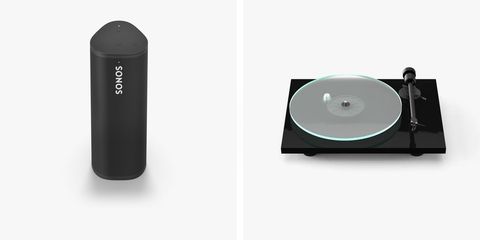For the past ten years or so I've been a musical rut, playing the same half-dozen, half-written songs on guitar once every other blue moon and listening to the same handful of punk bands I listened to in high school. I’ve been a musician for most of my life. Between church choirs, garage bands, and a cappella groups, I’ve been involved in organized (but never professional) music-making for the better part of several decades. But, after so long uninspired, I thought that maybe the musical part of my life was mostly behind me. Until the Tascam Portastudio 414 MKII brought it all flooding back.
-
 Tascam Portastudio 414 MKII 4-Track Cassette Recorder Read More
Tascam Portastudio 414 MKII 4-Track Cassette Recorder Read More
Released at the tail end of the 90s, the Portastudio 414 MKII harkens back to a time before MacBooks shipped with Garageband. If you wanted to record music with multiple tracks that could be altered independently, you were looking at booking studio time or buying something like this lovely big blue beast. And make no mistake, this chunky boy can deliver if you've got the chops. Bruce Springsteen's Nebraska, a few early Ween records, and some vintage Weird Al tunes were all recorded on a Portastudio of one make or another. More recently, Nine Inch Nails' Alessandro Cortini has been almost single handedly responsible for making the 414 MKII in particular cool again with his unorthodox (and extremely sick) use of the device as an instrument in live performance.
The 414 MK II lets you record four independent tracks to a humble cassette tape, just enough room for bass, guitar, vocals, and drums, with the ability to add more if you’ve got the nerve to "bounce down" multiple instruments to the same track, irrevocably intertwining two rivers of sound to free up a slot for additional recording. It’s ridiculously limited compared to the "digital audio workstations" you can get literally for free today. but it does come with one killer feature that has only truly emerged in the millennium following its original launch: You don’t have to stare at a fucking screen to use it.
I only ever recorded one (very poorly performed) song with my Portastudio when my parents gifted it to me back in the mid-aughts, and for almost twenty years I hadn’t really thought about it at all. But when an album cover featuring its unmistakable visage cropped up on my Spotify, it lit a spark in my brain. Mom knew just the closet where it had spent a decade plus hiding and soon, with a package of fresh cassette tapes in hand, I was ready to hit record.
The joy of working in an analog medium, as lovers of film photography can attest, is both the friction and the flavor it brings. Light leaks can spice up an otherwise average photograph. A little tape hiss can give your jam that extra flair. The cost, of course, is that your mistakes get baked all the way in, for better or worse. No undo buttons here. You have to move slowly and skillfully to find success. And so my plan to record guitar, bass, and vocals quickly hit a not-insignificant snag: I am neither a particularly good recording artist nor a remotely competent audio engineer.
After a few hours of trying and failing to adequately record the beat-to-shit Yamaha FG-335II I stole from my dad on my way to college 16 years ago with a unidirectional dynamic mic not remotely fit for the task, I tripped and fell into a whole other rabbit hole. What you really need, the gear gremlin between my ears sweetly whispered, is a drum machine. Also a synthesizer.
A bit of research and a few impulse buys later, I was finally in business:
Like any amateur analog artifact, this track contains mistakes encased in amber. The hi-hats are too hot because I didn’t balance the levels of the individual drums in my sampler before committing the whole drum track to tape. The bass comes in awkwardly because I was doing dynamics live to tape with the synth's volume knob instead of using a fader during mixdown. The solo, well, it is what it is. But the Portastudio saved my ass, not (only) with tape hiss, but by helping me take a deep breath and put this song to bed. I won’t waste hours trying to improve on the raw material with endless tiny tweaks, because I can't. Lessons (hopefully) learned, on to the next jam!
In the months since that inaugural recording, the road of my obsession has taken me away from analog, and towards digital devices that can synthesize and sequence a song’s worth of instruments inside themselves (still no computer screens allowed). At the moment, I’m in love with my "Woovebox," a petite-but-powerful one-person labor of love out of Australia, while I simultaneously lust after the wickedly slick, murdered-out Dirtywave M8 Tracker, a Gameboy-sized studio in a handheld.
If the two of us didn't go so far back, I might consider flipping my Portastudio on the secondary market, where the prices are currently sky-high. I could probably get more for it now than my parents originally paid and finance a big chunk of this or that digital dalliance. But in a way, I'm glad to be spared the temptation. Because if there's anything I've learned over the past twenty-something years, it's that the odds are very high I'll come crawling back to cassette.
-
 Tascam Portastudio 414 MKII 4-Track Cassette Recorder Read More
Tascam Portastudio 414 MKII 4-Track Cassette Recorder Read More























